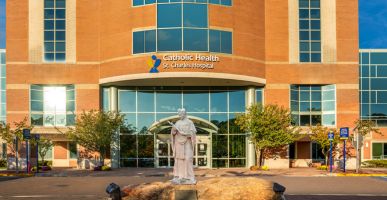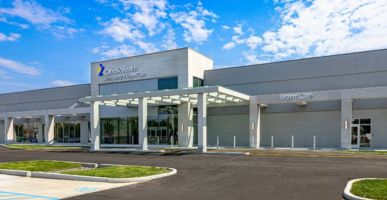Returning to Daily Life Pain-Free
Chronic pain in any area of the body is disruptive and keeps you from doing what you love. At Catholic Health, our board-certified pain management physicians look at your whole person to determine the source of pain and develop a treatment plan unique to your needs. Our goal is for you to enjoy a pain-free, productive life.
Your pain management physician collaborates with Catholic Health's vast network of specialists across Long Island to provide the care you need. You have access to renowned experts in areas including neurology, orthopedics, and physical therapy and rehabilitation. This personalized approach means you, your physician and your care team work closely together to manage your pain so you are not limited in your daily activities.
Our Pain Management Program
Catholic Health pain management centers across Long Island offer comprehensive, multidisciplinary services performed by some of Long Island's leading pain medicine physicians who use a variety of advanced procedures to treat painful conditions.
We treat all types of pain. If your condition isn’t listed, we have specialists who can help. Conditions treated include:
- Back pain
- Chronic pain that does not respond to conservative pain relief measures
- Hip pain
- Knee pain
- Myofascial pain syndrome—pain radiates from one or more trigger points in your muscles stimulated with or without pressure
- Pain that can’t be relieved with surgery
- Pain that demands an increasing need for opioid medications
- Pain that follows an injury
- Post-surgery pain
Our team of pain management specialists includes:
- Board-certified pain management physicians
- Board-certified anesthesiologists
- Board-certified physiatrists (physical therapy and rehabilitation)
- Registered nurses
- Physical therapists
- Physicians in multiple disciplines
Treatment Options
Catholic Health pain management specialists use the latest, most advanced treatments to treat all types and pain levels.
Epidural or Spinal Injection with Opioids or Steroids. Delivers opioids or steroids directly into the epidural space between the vertebral canal and the spinal cord.
Sacroiliac Joint Steroid Injection. Relieves pain caused by arthritis/inflammation in the sacroiliac joint where the spine and hipbone meet.
Lumbar Transforaminal Epidural Steroid Injection. Relieves low back and radiating leg pain.
Cooled Radiofrequency Ablation for Knee Pain. Treats knee pain without surgery. Applies a sophisticated type of radio wave to the nerves surrounding the knee.
Nerve Root Injections. Treats pain caused by spinal cord inflammation and helps diagnose the source of the pain.
Trigger Point Injections. Relieves muscle pain in your arms, legs, lower back and neck.
Botox Injections. Treats chronic back pain, neck pain or migraine headaches.
Epiduroscopy. A minimally invasive technique used as a pain-relief tool for chronic back pain. It can also be used to diagnose the exact place your pain originates.
Nucleoplasty. A minimally invasive procedure developed to treat patients with mildly herniated discs.
Percutaneous Electrothermal Disc Treatment. A minimally invasive treatment for low back pain caused by a disc.
Radiofrequency Lesioning. A minimally invasive procedure that disrupts nerve signals and relieves pain in your back.
Radiofrequency Ablation for Headaches. A minimally invasive procedure that uses heat energy to reduce the pain signal from your nerve to your brain.
Nerve blocks are a type of injected anesthesia to help reduce inflammation and prevent pain signals from reaching the brain. Nerve blocks can be nonsurgical or surgical.
All Forms of Nerve and Facet Blocks. Treats pain that comes from facet-joint arthritis. Also used as diagnostic tests to find out the source of your back pain.
Intercostal Nerve Block. This treatment helps relieve pain in the chest area caused by shingles.
Baclofen Pump. Baclofen is a muscle relaxant. It can be used with a pump that is implanted under the skin of the abdomen with a catheter to your spine to relieve pain.
Implantable Narcotic Pump. Narcotics are used to relieve pain in certain circumstances. The pump is inserted in your abdomen with a catheter that delivers the narcotic to your spinal fluid with a narcotic pump.
Cryoneurolysis and Cryoablation. Cryoneurolysis uses extreme cold to treat a peripheral nerve. This treatment lasts for weeks or months. Cryoablation freezes nerves to block pain.
Manometric Discography. This is a test to confirm whether the pain originates in your spine.
Peripheral Neurolysis. A peripheral nerve can become trapped by scarring, which makes it painful. Peripheral neurolysis removes the scar tissue.
Spinal Cord Stimulation. This implanted device sends low levels of electricity directly to your spinal cord to relieve pain.
Interventional Pain Treatment for Cancer. These treatments interfere with the pain signal in your body’s nervous system.
Neurolytic Blocks. A type of nerve block used for patients who have various types of cancer.
Pain Management Locations

Good Samaritan University Hospital
West Islip, NY

Mercy Hospital
Rockville Centre, NY

St. Charles Hospital
Port Jefferson, NY

St. Francis Hospital & Heart Center
Roslyn, NY

Catholic Health Ambulatory Care at Centereach
Centereach, NY

Catholic Health Ambulatory Care at Commack
Commack, NY

Catholic Health Ambulatory Care at Patchogue
Patchogue, NY

Catholic Health Ambulatory Care at Riverhead
Riverhead, NY

Pain Management, Ambulatory Care at East Hills
East Hills, NY

